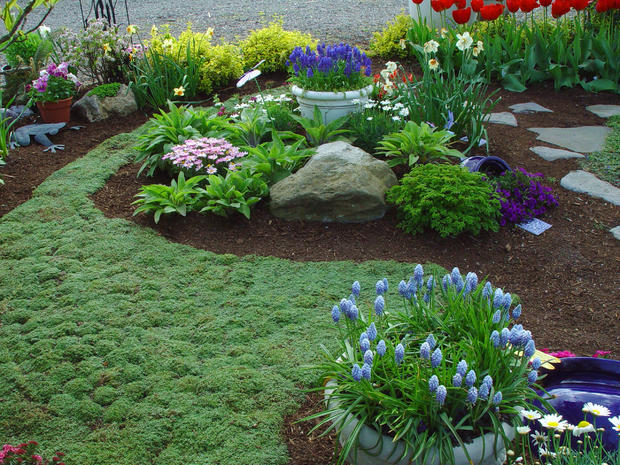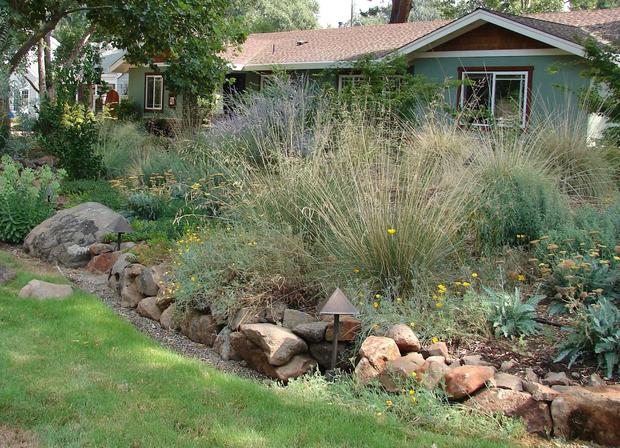5 ways to create a grass-free garden
A yard with a carpet of lush, green grass, stereotypically bordered by a white picket fence, has long been part of the dream of homeownership.
But really, grass is lazy.
"Most people have too much lawn because they don't know what else to plant there," said Daryl Pulis, a landscape designer and master gardener known throughout the Atlanta area as Mrs. Green Thumb. "A soil covered with lawn or other plants is often required before a builder can sell because it stops erosion, and lawns can be established quickly. Once there's something green, people are often reluctant to get rid of it."
As any homeowner can attest, that green grass sometimes is more of a pain than it's worth. A nice lawn requires a lot of maintenance: Watering, cutting, weeding and trimming. Throw kids or pets into the mix and the grass is getting destroyed and rebuilt regularly.
Fortunately there are a number of solutions to either eliminate your lawn or at least significantly reduce it so there's less to maintain and more visual interest played up in your yard.
Consider the function and design of your yard before picking out replacement plants, said veteran landscape architect Ted Cleary, principal of Charlotte-based Studio Cleary Architecture.
"Think about what you are going to use it for," Cleary said. "Are you the type of person who's very solitary, happy to live a very quiet life and you don't have a lot of visitors or will you have five to 15 people over all the time."
That will help you determine the ratio of hard ground cover to soft ground or gardens. Then consider what you want to see -- water features, lush flower gardens, a big patio, green lawns, vegetable gardens -- and how those things will function in your yard.
"A lot of people are intimidated by the idea of designing their landscape, but if you start with what you want and where the plants will be happy, you have most of the battle won," Pulis said.
Try a green ground covering
There are actually a number of different ground coverings in multiple shades of green. Though they aren't as versatile as grass, they certainly look the part while requiring much less attention.
Consider a few species, such as the Dymondia margaretae, which is also known as silver carpet due to its green-gray hue and Dwarf mondo grass, a grass-like plant that thrives in the shade and grows similar to ivy. Start by planting individual plants a few inches apart and allowing them to grow together. If you're looking for something a little more foot-friendly, try Mazus reptans. Blue sedge, creeping Jenny or creeping thyme -- which offers that thyme scent when stepped on -- are also good options.
Pros: These plants really look like grass from afar, but require very little or no mowing. Plus they stay green longer with less water.
Cons: Unlike grass, these plants can't take much foot traffic, so you can't go lay out on the lawn or play fetch with Fido. Plus some may take a few years to fully "fill in" the yard and really mimic the look of grass, while others, such as the creeping Jenny, may become invasive.
Install a gravel bed
A bed of gravel, such as pea gravel or round river rock, not only adds texture to your outdoor space, but provides a less expensive alternative to a deck and a more eco-friendly alternative to a patio, which doesn't allow the ground underneath to breathe and can encourage erosion. Plus a gravel or stone bed can be raked into different shapes, even a spiraling maze that is used for meditation.
Pros: Once installed, a typical gravel bed requires almost no maintenance, except the occasional refill.
Cons: A gravel bed does take some serious prep work to avoid a squishy, messy yard. Cleary recommends installing a square or honeycomb-shaped plastic grid on the ground and filling it with different types of stone materials, and then getting it mechanically compacted. Also consider edging off a border and adding plants around the gravel bed to keep the gravel in place so it doesn't wind up drifting all over your garden or yard.
Plant an edible garden
By converting your backyard into an edible garden, you're not exactly going the low-maintenance route, but at least your hard work translates into something you can use. By adding rows of planters with either gravel or a little grass in between, you can grow food for about six months in some climates, up to a year in others. You can even install a greenhouse in your backyard to extend your growing season. A small greenhouse, running about six feet wide and ten feet long, runs between $500 and $1,000.
Pros: Fresh food, potentially all year long, is the big draw. Growing a vegetable garden can also be a family-friendly educational activity.
Cons: This is not a low maintenance option. Caring for a vegetable garden will require more time and energy than almost any other option on this list, so it's a commitment. Plus it's really only appropriate in the backyard.
Contrast a deck or patio with plants ringing the edges
There's an infinite number of choices you can make when building a patio, from stones to bricks to lumber or pavement. If you build with stones, make sure they match the look of the house. For example, don't throw irregular blue and gray stones next to a red brick house, Cleary said. If you choose to build a wood deck but keep it low to the ground, make sure you add a little space between the soil and the deck. If you go with pavement, opt for a porous or permeable material, so that you don't create drainage problems for yourself or your neighbors.
Just because you're putting a hard cover over your grass doesn't mean you have to kiss your greenery goodbye. Ditch the grass outside the patio by planting a mix of low-maintenance flowers, shrubs, ferns and grasses. You can even strike a balance between hard cover and soft cover by planting some of those green, grass-like ground coverings between pavers or stepping stones.
Pros: This option is low-maintenance and allows you to set up a larger outdoor living space to actually eat and entertain.
Cons: Building a deck or patio is expensive and may require the help of a professional. By turning your lawn into a large hard surface you also sacrifice a soft place for children or pets to play.
Look for drought-resistant, native plants
Give your backyard back to nature and enjoy a peaceful, low-maintenance retreat. There are tons of resources both online, in print and at your local gardening center that can point you toward plants that thrive in your area. Think of texture, height and color when plotting out the overall design and then focus on plants that are evergreen, don't require a lot of pruning, come back year after year, and fit the conditions where you want to plant them (for example, some plants want to bake in the sun while others thrive in the shade).
Pros: Native, drought-resistant plants are abundant, typically inexpensive and require very little maintenance to get growing. Plus they won't do much damage to your water bill.
Cons: The easy growth of native plants has a flip side though. They tend to grow too much and get a little unruly, which can ruin your garden's intended effect. So check first with a garden specialist about how and where to plant to minimize overgrowth, and be prepared to put some sweat into maintaining your garden.





